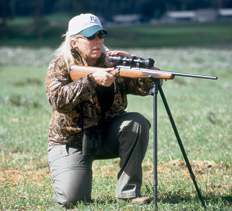Ground squirrels provide a superb proving ground for field testing rifles, optics and ammo under real-world conditions.
It wasn’t exactly a scene from CaddyShack—or even remotely close, actually—but I could relate to the grubby assistant groundskeeper’s quandary as I pondered the gopher-infested pasture. Carl would’ve had his work cut out for him. I hunkered down, rolled up my sleeves and got down to business.

The immense Montana landscape—rolling pastures that mingled with shouldered foothills framed by the majestic mountain peaks of the Bob Marshall Wilderness Area—provided a breathtaking backdrop. I inhaled deeply and soaked it all in. Then I sipped another breath, released half of it and tightened the trigger on the Remington Model 700. The unfortunate Columbian ground squirrel in the crosshairs died with gusto. I panned over to the next vertical sentry and repeated the process. Talk about a target-rich environment! I continued to pull the trigger until the ground beside me was littered with spent brass.
Ground squirrels provide a superb proving ground for field testing rifles, optics and ammo under real-world conditions. Available in ridiculous numbers, and loathed by ranchers for their destructive nature and the diseases they carry (including bubonic plague), they’re the perfect treatment for the withdrawals many riflemen suffer when big game seasons are closed.
And so here I was in west-central Montana, lying prone with a sweet-shooting rifle topped with sniper-quality optics, and a huge pile of ammo. I couldn’t imagine a more pleasant way to spend a mid-May afternoon.
Head West
If there’s an ideal setting for field testing varmint rifles and ammunition, long-range optics, and for improving shooting skills, it’s the vast reaches of the American West. Whether you’re pursuing prairie dogs in South Dakota or Wyoming, striped gophers in North Dakota or, as we were, Columbian ground squirrels in Montana, you can put your equipment and marksmanship to the ultimate trial.
For varmint hunters, the West is quite literally the land of opportunity—vast open ranges populated by a wide variety of living, moving targets. Columbian ground squirrels are plentiful throughout much of the northwestern United States and western Canada, preferring open meadows, cropped pastures and dry grasslands. Typically, they live in large colonies where they raise their young. Females produce one litter a year, with as little as two or as many as 15 young. They only live a few years on average, but because they can reproduce at an early age populations left unchecked can quickly escalate.
And public land is plentiful. The Bureau of Land Management alone manages 262 million acres (most of it in the Western states), or about one-eighth of the land in the United States. Much of this property is dominated by extensive grasslands and pastures, perfect varmint habitat in other words. Other large tracts of public land include those controlled by the U.S. Forest Service and U.S. Fish and Wildlife Service. Add state wildlife management areas and it’s obvious there’s no shortage of accessible places to hunt.
But don’t overlook private property, because access is often available for the asking. Ranchers tired of pastures that resemble Swiss cheese frequently greet varmint hunters with open arms, as long as they steer clear of their cattle and close gates behind themselves.
Whether on public or private land, shooters can set up overlooking vast grasslands or pastures and shoot for hours without moving. Lessons learned at the rifle range are reinforced by expending large volumes of ammo under real-world field conditions.
Shooting varmints provide a forum for practicing from various positions while calculating elevation, wind-drift, and angle. In other words, it’s an excellent primer for all the other rifle hunting you do. For me, it was a chance to get away from the shoulder-punishing magnums and shoot the light stuff: .204 Ruger, .17Mach2 and .22LR. And a chance to burn a lot of ammo in the process.
Trigger Touch
Arguably the most important—and often overlooked aspect of accuracy—begins and ends at the tip of the index finger. Aside from the mechanical aspects of what constitutes a good trigger, the physical requirements of breaking that trigger clean like everything else requires good form and practice.
Gunwriter Ian McMurchy shoots more than anyone I know. He’s a North American guru of all things that go bang. He sees the trigger as the final link in a chain of events that affect shooting proficiency and accuracy. A hunter might spend hundreds of dollars on a new rifle and several hundred more on a new scope, but give little thought to the quality of the trigger.
“Very simply, you cannot expect to shoot to your accuracy potential or that of the rifle if the trigger has a heavy release weight, excessive creep or over-travel,” McMurchy said. “Unfortunately, today many triggers come from the factory ‘lawyer-proof’ because of fears of litigation, and the heavy release weight and movement impair accuracy. It’s imperative to know exactly when the trigger releases the sear, simple as that. When the sight-picture is correct and steady, you want the rifle to fire at an exact instant in time. You ‘will’ the trigger to break—it’s a subconscious act.”
But as important as a good trigger is, good technique is also required to make an accurate shot, and the physics of marksmanship begin and end with the trigger.
McMurchy cites several key elements that ensure a good trigger pull.
• Position the hand naturally with your palm slightly cupped, controlling your grip with the bottom three fingers. Use the forward pad of the trigger finger, with your thumb either over or along the tang.
• Break the trigger at the “natural respiratory pause” that occurs between evenly spaced breaths—don’t hold your breath at any time.
• Natural point-of-aim involves using the entire body for a shooting platform, supporting the rifle with bones, not muscles because of muscles quiver. Follow through with steady pressure on the trigger and constant cheek weld on the stock. Hard-kicking rifles must be controlled with force; use the left hand if necessary. Never let the sling stud contact the sandbag or whatever rest you might be using.
And what better place to practice the mechanics of good marksmanship, including trigger control, than the target-rich environment of the West? “Where else can you shoot so many rounds in a short time at such varied distances?” McMurchy said. “Consideration of wind, mirage, bullet drop, barrel heat and other factors all blend into a continuous stream of decisions you have to make each time you pull the trigger.”

